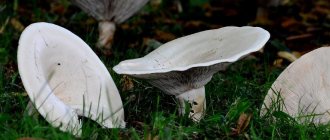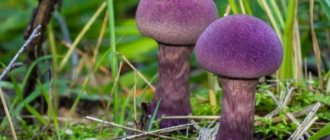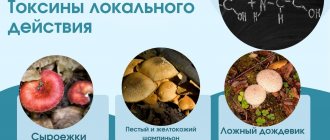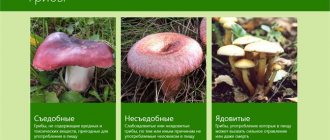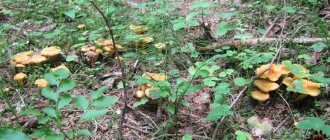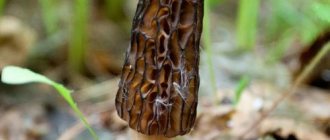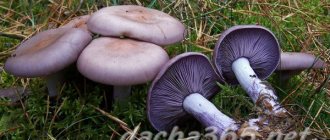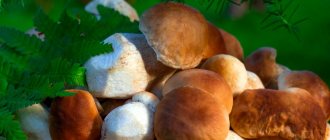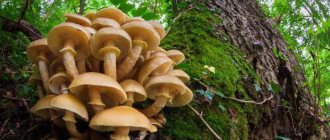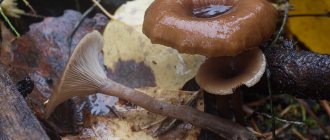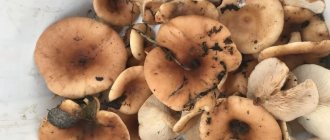During a quiet hunt, mushroom pickers encounter a wide variety of mushrooms, some of them grow in groups, others grow separately, some can be freely eaten, others should be avoided due to their toxicity. In order for the basket to end up with exceptionally tasty and safe representatives of the mushroom kingdom, you need to be able to understand their types. So you should avoid the inverted talker, which contains substances close to muscarine. The appearance of a forest fruit can confuse an inexperienced mushroom picker, but it should be remembered that in a quiet hunt you should first of all rely on knowledge, not your eyes.
Govorushki goblet and orange
Govorushka goblet in the photo
Govorushka goblet. The cap is up to 8 cm in diameter, broadly funnel-shaped, goblet-shaped or cup-shaped, with a downward-turned edge, shiny, silky, and when moistened, seems to be saturated with water. The entire mushroom is dark ash-gray or brownish-fawn. The plates are adherent or descending along the stalk, rather sparse, sometimes branched, light brown or brownish-brown. The pulp is thin, grayish, watery. The spore sac is white. The leg is up to 10 cm high, elastic, hollow, thickened at the bottom, fluffy at the base. It grows in coniferous, mixed, broad-leaved forests on the forest floor, fallen pine needles, rotten wood, and is quite common. Fruits in August – September.
Edible mushrooms are eaten boiled and salted. High quality mushroom.
Orange talker in the photo
Rare edible agaric mushroom
Orange talker is a rare edible agaric mushroom. Other names are cocoshka or false chanterelle. It grows singly or in small groups, producing stable harvests annually from early August to late October. Favorite habitats are damp areas of mixed or coniferous forest, covered with a thick layer of moss or fallen leaves, as well as rotting trunks of pine trees lying on the ground.
Similar species
Two-colored lepista (Lepista multiformis) is larger than an inverted talker and is found not in the forest, but in pastures.
Lepista bicolor
Funnelhead (Clitocybe gibba) is found in similar habitats, but this mushroom is paler and has longer, stone-shaped white spores.
Funnel talker (Clitocybe gibba)
Taxonomic history
The inverted talker was described in 1799 by the British naturalist James Sowerby (1757 - 1822), who classified this species as Agaricus flaccidus. The talker acquired its now recognized scientific name Lepista flaccida in 1887, when the French mycologist Narcissus Theophilus Patouille (1854 - 1926) transferred it to the genus Lepista.
Talkers whitish, whitish and reddish-brown
White talker in the photo
Clitocybe candicans in the photo
White talker (Clitocybe candicans). The cap is 1.5–5 cm in diameter, convex at first, later straightened to concave, the edge is thin and drooping. The skin is at first slightly mealy, then shiny and smooth. The color is white, sometimes with a faint pink tint. The plates are frequent, slightly descending, white. The pulp is thin, white, the smell is inexpressive, the taste is pleasant.
The stem is 2–4 cm high, up to 0.5 cm in diameter, cylindrical, often bent at the base, tomentose. The color is white or yellowish.
Description
The talker is upside down.
hat
The size of the cap reaches 4-8, occasionally 10 centimeters. At a young age, the cap is convex, but not for long, very quickly it becomes prostrate, and then funnel-shaped with bent, slightly wavy edges.
The color of the inverted talker is very variable and depends on air humidity and the amount of precipitation. It can be red, red, brown or many transitional shades between them; the higher the humidity, the darker it is.
Spore-bearing layer
The talker is red-brown.
Lamellar. The plates are thin, often located, adherent to the stem and flowing down the stem. The lamellar layer is initially cream-colored; as it matures, it becomes reddish-brown with an ocher tint. White spore powder.
Leg
The length of the leg of an inverted talker reaches 4-5 centimeters, and its thickness is about 1 centimeter. It is colored to match the hat, sometimes a little lighter. The structure is solid, cross-fiber, rigid.
Pulp
It is colored fawn, has a burning taste and a pungent, pungent odor.
How to cook?
Cooking talker mushrooms is no more difficult than any other variety of mushrooms. You can boil, fry, bake these products, use them as a main snack, or add them to other dishes. In our article you will find recommendations that will help you decide how best to prepare talkers at home.
There are a large number of all kinds of recipes for preparing dishes with talkers, in which mushrooms are even used as a filling for baked goods or rolls. But it will be tastiest to cook them as a separate dish, for example, fry or boil.
- Most housewives advise boiling the talkers before frying them, but during cooking, most of the beneficial microelements and flavor components are boiled out of the mushrooms. Therefore, you should cook talkers before frying only if you are not sure whether they are all edible. It is best to place the ingredients in the pan while still raw. First wash the mushrooms and remove leaves, dirt and debris, then cut the talkers into pieces convenient for you and place them in a frying pan with oil. You can also fry mushrooms in a multicooker using the “Frying” mode by placing the ingredients in the device’s container and waiting for the required time. When cooking, a characteristic mushroom smell may appear, which not everyone likes. But when the mushrooms are fully cooked, this aroma will disappear. While frying, add finely chopped onions, ground allspice, salt and other herbs and spices that you like to the mushrooms. You can also pour a little sour cream into a frying pan or saucepan, stew the mushrooms in it and prepare a delicious appetizer!
- You should cook the talkers immediately before frying for no more than ten minutes, since the ingredients may crumble during subsequent heat treatment. If you plan to seal the mushrooms for the winter, then they should be boiled in a ready-made marinade, adding all the spices in advance and bringing it to a boil. If you just like to eat boiled mushrooms, add salt to the boiling water, then add the talkers cut into pieces and boil them until the products turn white and their consistency is soft enough.
Among other things, talkers can be baked with meat or potatoes. To do this, the mushrooms are cleaned, washed, cut into pieces and placed on a baking sheet, covered with potatoes or meat. You can experiment with preparing talkers as your imagination allows.
Basic rules for growing strawberries at home in winter
Inexperienced gardeners believe that a greenhouse is a salvation from many diseases and pests, and the berries in it will be completely safe. In fact, when growing indoors, there will be much more diseases, in particular due to the lack of quality ventilation. Therefore, it is necessary to face troubles head on and know the basic methods of combating the most common fungi, infections and pests.
- White rot. Due to the high relative humidity indoors, white mold may form on the strawberries, which looks somewhat like a very thin cobweb in clumps. The leaves on the plant suddenly begin to lighten and dry out after a couple of days, and the berries in the affected areas rot. The mycelium cannot be eliminated by practically anything, it is very resistant to drying out, so raising the temperature and lowering the relative humidity will do nothing. Control measures are drastic - removing infected berries and leaves and burning them. As a preventive measure, it is necessary to increase the room temperature and install a dehumidifier - most of the fungal spores will die, while others will simply be inactive.
- White spotting. Almost every gardener knows her, since it is very difficult not to meet her. The first symptoms: the leaves become speckled with white, such circles can be up to 8 millimeters, they are brown at the edges, the center is very light, almost white, which is why the disease is called that. It develops, as a rule, during the flowering period of berries, destroying leaves, stems, and sepals. Peduncles may change color and become darker. The disease progresses with abundant watering and high relative humidity in the room, as well as high planting density. It can cause the loss of the entire harvest if you do not fight back in time. Treatment consists of treatment with Falcon, Euparen, or copper sulfate (the proportions are written on the packaging of the drugs).
- Brown spot. An equally common disease, which, in special cases, “mows down” up to 60% of all plants. As a rule, in the first half of the season it does not make itself felt, or appears only on some bushes, and by the beginning of August it begins to progress fully. The leaves darken at the edges and acquire a bright brown color, then darken a little and dry out. The disease is very dangerous not only for the harvest, but also for the propagation of strawberries, as it affects leaves, flowers and even tendrils. The fungus multiplies and hides on the affected plant, and overwinters on it, so the most effective method of control is to remove the affected branches as soon as the fungus is diagnosed. Preventive spraying with Euparen and Metaxylene will ensure increased plant resistance to damage by this type of biological activity.
- Powdery mildew is the greatest enemy of greenhouse plants. At high relative humidity, as well as at low temperatures, it develops exponentially. The disease can be identified by the characteristic white coating that forms on the underside of the leaf blade. After a while, it appears on top and then throughout the plant, including flowers, tendrils and sepals. The leaves curl into a “pipe”, after which they dry out and fall off, the plant stops synthesizing organic substances and dies. You can fight powdery mildew using copper sulfate, soap solution (4%) and Quadrix. But it’s easier to remove infected plants and monitor the optimal humidity in the room.
- Root blight. Very insidious zoospores that are found in the soil infect the root system, mainly at the end of May, when the soil temperature reaches 20 degrees. Gradually, the roots turn red and die. As a result, the plant dries out. It is very difficult to diagnose and, in most cases, gardeners see the problem after “opening” the bush - the roots have turned red and dried out. You can try to determine the symptoms by the leaves - young leaves are much smaller than expected and are too light. Treatment with Quadrix helps by 70%, and the main method of control is to remove diseased plants and improve the health of the plantation.
It is not only unprofitable to treat many diseases, but also pointless, since it will take a lot of time and the bush will not bear fruit anyway. If plants die in isolated cases, then the best way to get rid of the problem is to get rid of the plant itself. If you trace a pest invasion or mass infection, then you need to resort to chemistry and change the conditions in the greenhouse.
Edibility
Here you need to show special care. Some sources say that the inverted Talker is poisonous, since it contains toxins and substances harmful to the human body, while other sources say that it is not poisonous, but it does not contain a large number of useful trace elements or minerals, so its nutritional qualities do not have any or meaning. There is no point in collecting this mushroom.
In general, it is classified by mycologists as an inedible group. Even with prolonged heat treatment, they are not eaten.
Where do they grow, in what forests?
These mushrooms prefer to grow in moist soil in dense coniferous and sometimes mixed forests. Their main companions are moisture and darkness, so they can often be found near spruce and pine trees. They can also grow at the foot of anthills, on damp wood chips, rotting stumps and humus-rich soils. Growing on the latter, they form spectacular so-called “witch rings”. As a rule, they are found in groups, 10-15 specimens in one, which also distinguishes them from many other representatives of the genus.
They grow everywhere, so they can be found in all European countries, including Russia, as well as in North America, Iceland and Ireland. Despite the fact that the period of active growth of the talker occurs in autumn, in some regions it grows from summer until the first frost, completely retaining its appearance.
Interesting!
It is noteworthy that in regions with a warm climate, such as the state of California in the USA, the mushroom can grow almost all year round.
First aid for poisoning
The complex of toxins contained in the talker can cause quite severe poisoning. If a person somehow or accidentally eats this mushroom, then you should immediately call an ambulance.
Before medical help arrives, it is necessary to prevent dehydration in the body after excessive vomiting and diarrhea. The following measures must be taken:
- Drink plenty of fluids to prevent dehydration from developing to extremes (you can prepare a saline solution of 1 teaspoon per 1 glass of water or use pharmaceutical products such as Regidron and other analogues)
- Use enterosorbents to remove harmful substances (enterosgel, polysorb solution, activated carbon can help with this)
- If the temperature is elevated, it is necessary to take antipyretic drugs (ibuprofen)
- You should lie in bed, warm heating pads should be placed on the legs and stomach of the person affected by poisoning
There are cases when there is no diarrhea and vomiting, and then it is very difficult to diagnose poisoning. This can lead to various serious consequences, since harmful substances will not leave the human body. Also, as first aid, it is necessary to artificially induce vomiting - you can drink 1.5 liters of potassium permanganate and press on the root of the tongue.
Contraindications
Mushrooms should not be consumed by people with gastrointestinal problems
In some cases, the use of this mushroom is strictly prohibited:
- children under 12 years of age;
- period of pregnancy and lactation;
- stomach diseases - ulcers, gastritis;
- epilepsy;
- problems with the thyroid gland;
- urolithiasis disease.
Excessive abuse of forest products can provoke a number of undesirable side effects: an allergic reaction, increased bladder tone, disruption of the digestive tract and dysstabilization of the function of the cardiovascular system.
The maximum dose per day for a healthy person is no more than 150 g.
Biology
Representatives of the order Hypocreaceae are saprotrophs in soil, wood, and various plant debris. In addition, the order includes a large number of phytopathogenic species that parasitize many higher plants, fungi, insects, lichens, and myxomycetes. Some representatives of this order are coprotrophs. In particular, the genus Selinia. Species are known that live in the seas on wood immersed in water.
In the development cycle of species of the order, there is often a conidial stage, which prevails over the marsupial (teleomorphic) stage in duration. Typically, conidia develop on a living plant, and ascospores develop on dead parts of it, under saprotrophic conditions. The conidial stage plays an important role in dispersal in some species. Sometimes it completely replaces the marsupial.
Conidia are usually phialospores formed on solitary conidiophores or conidiophores collected in sporodochium or in pycnidia. In a few representatives of the order, aleurospores and blastospores are formed.
Symptoms of poisoning
Harmful toxins accumulate in the body for about 2-3 hours, and after this time the first signs of poisoning appear. Poisonous mushrooms have a high content of poison and harmful substances, so they can cause a reaction within 20 minutes after eating them. But the talker contains less dangerous toxins, so instant results are impossible.
Symptoms of poisoning may include a person having:
- Slight dizziness
- Slight decrease in blood pressure
- Drowsiness
- Decreased muscle tone
After some time, mild signs are complemented by serious symptoms:
- Nausea with increasing vomiting
- Diarrhea
- Sharp pain in the upper part of the stomach
- Changes in skin tones
- Sweating
- Drooling
- Tachycardia
- Pressure surges
Dehydration is caused by vomiting and diarrhea. This may lead to other symptoms: drowsiness, fever, weakness, vision problems and difficulties with coordination.
